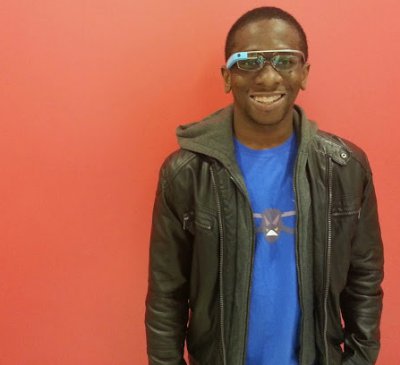The walls of Fredia Huya-Kouadio’s apartment are scuffed up. They’ve got black marks all over them, from the times his AR Parrot has crashed into them. But these days, it happens much less often: Huya-Kouadio has successfully managed to fly it using just Google Glass. Moving his head left turns it left, moving it right turns it right. A finger swipe to the side of Glass alters its altitude.
He’s not the first one to fly a UAS using Google Glass, but he is, he says, the first one to do it natively through Glass’ version of Android. Belaine Bublitz wrote a programme that sends Javascript commands from Glass, through a computer, and to the AR Drone. Huya-Kouadio’s programme cuts out the middleman.
“Glass already has all of the components that regular Android already has, so we can bypass the computer. It’s just Glass straight to the aircraft,” Huya-Kouadio said. “Basically, the idea is, if it works on an Android smartphone, it should work on Google Glass.”
 Huya-Kouadio debuted his technology, which he calls Glasskinesis, at Saturday’s first annual DC Drone User Group Conference in Fairfax, Virginia. The conference brought about a hundred drone hobbyists to George Mason University to discuss issues such as FAA authorization to fly drones, how 3D printing and drones go together, and safe flying techniques. The conference was originally to be without demonstration, but when Timothy Reuter, president of the organization, saw Huya-Kouadio wearing Glass, he asked him if he could fly it.
Huya-Kouadio debuted his technology, which he calls Glasskinesis, at Saturday’s first annual DC Drone User Group Conference in Fairfax, Virginia. The conference brought about a hundred drone hobbyists to George Mason University to discuss issues such as FAA authorization to fly drones, how 3D printing and drones go together, and safe flying techniques. The conference was originally to be without demonstration, but when Timothy Reuter, president of the organization, saw Huya-Kouadio wearing Glass, he asked him if he could fly it.
“When we said no drones, we meant the big stuff that’s going to smash the windows,” Reuter said. “Parrots are always welcome. You’re not going to hurt anyone or anything with it.”
That’s good news for Huya-Kouadio, who’s an Android programmer by day. He said he’s crashed the drone in his apartment numerous times, but has never caused any major damage. That could change with his next project, which is to build a drone and custom-program it to work with Glass. He eventually plans to release the open source app so others can improve on it and modify it to work with other drones.
“I’m still in the beginning process with that, but once I can get [a custom built] copter flying, I’m going to focus on it,” he said. “When the AR drone is flying, you can see what it’s seeing. The problem is, it doesn’t have a huge range, so you’re limited to line-of-sight flying. The plan is to be able to fly [bigger drones] in first person view without line-of-sight.”
Huya-Kouadio’s drone moves with the slightest of head movements. The plan is to make flying a drone an afterthought.
“My goal is to make the technology as human as possible. When you control it, you don’t even realize you’re controlling something else because it reacts one-to-one with what you’re doing,” he said. “It’s like being a bird, you’re kind of flying yourself. That’s the final experience I want to get.”
